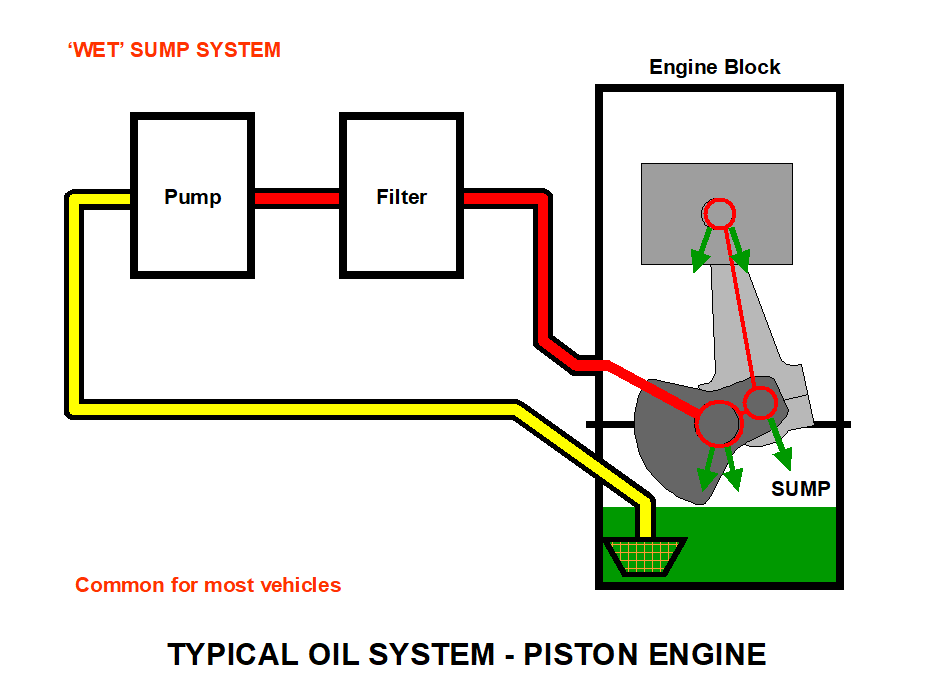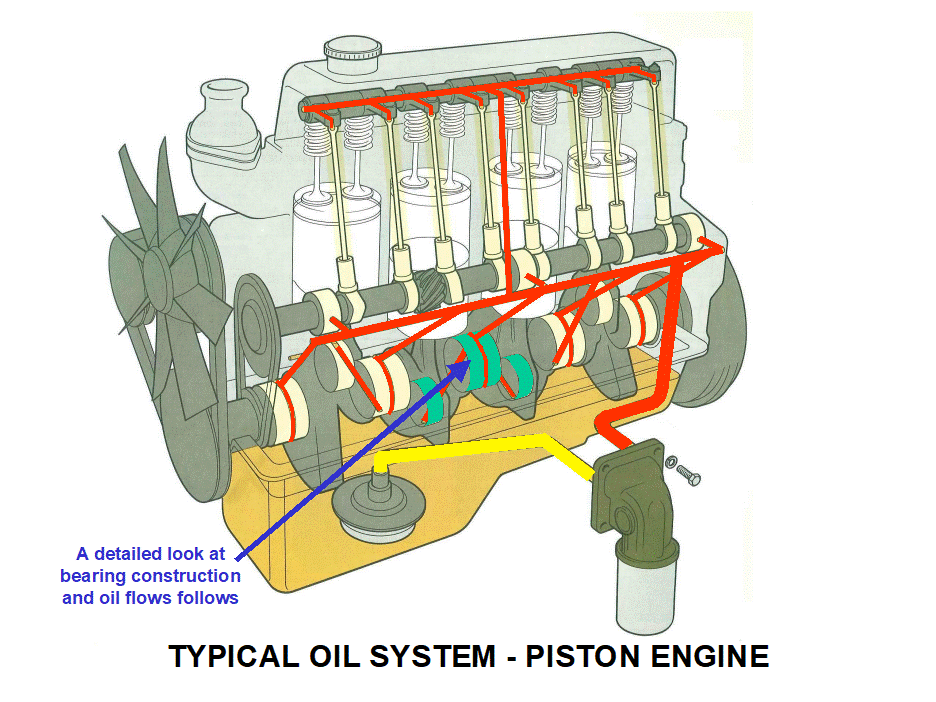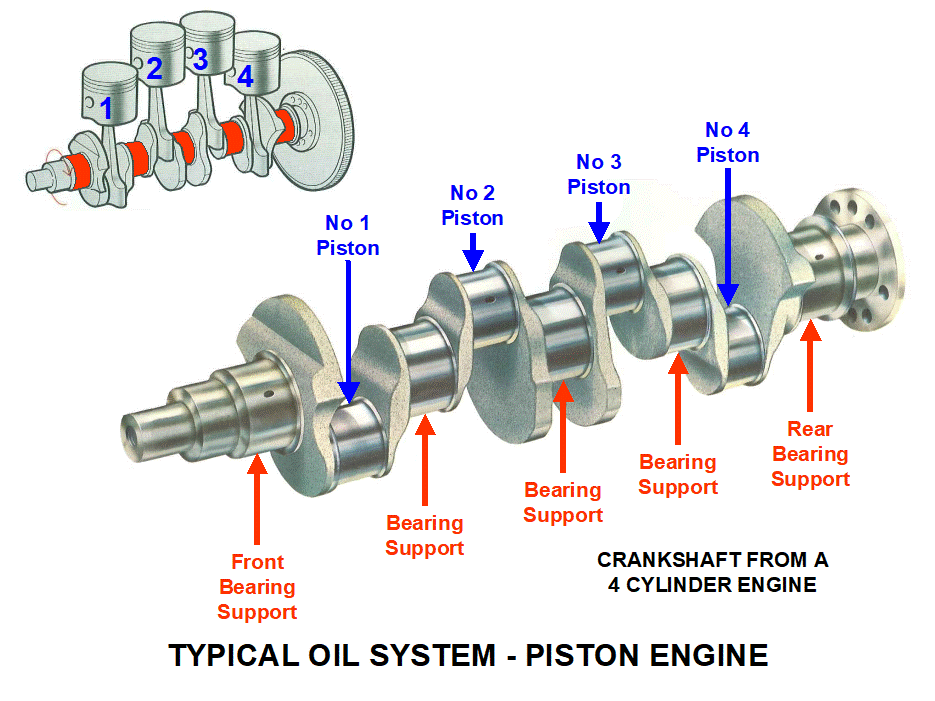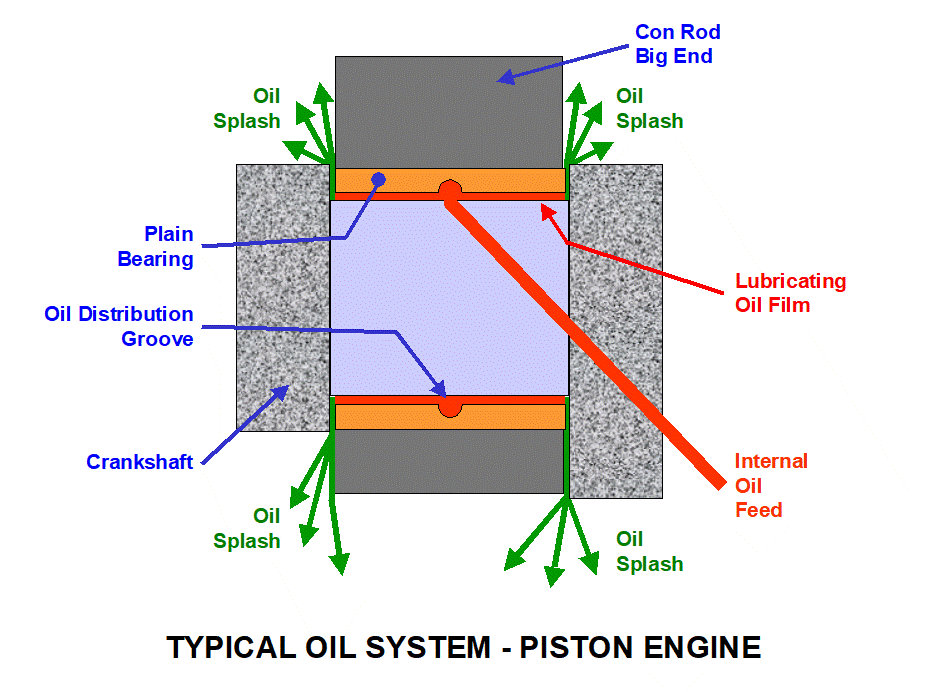CHAPTER 4 - OIL SYSTEM
Oil System – ‘Wet’ Sump System
Introduction
Lubrication is used between 2 sliding surfaces overcoming friction, the resistance between sliding surfaces, and therefore preventing or reducing component wear.
The properties demanded from a lubricant vary considerably with the particular application. A lubricant for a bicycle is not suitable for a steam engine; the load and working temperature vary in each instance. In general, a lubricating oil for any engine should be of a suitable viscosity for maximum loads and also retain this viscosity over the full range of engine temperature.
Note: Viscosity = resistance to change of shape.
System Operation
In most piston engines, it is common practice for the oil to stored in the sump, the bottom casing of the engine.
The oil us pulled out of the sump by an engine driven pump, through a strainer. The oil provides the flow and the close fitting components that it lubricates cause the pressure to rise.
When the engine and oil are cold, and at higher rpm’s when warm, the pump could be damaged by the resultant excessive pressures, This is prevented through a pressure relieve valve. For instance, if the relief pressure is set at say 50psi, at 49psi the valve would close and all the oil is delivered to the engine, at 51psi the valve would open returning excess oil to the sump, therefore limiting the pressure to 50psi.
The oil then passes through a filter to ensure it is sufficiently clean to prevent damage in the engine bearings and blockage etc. then passes into the engine.
The oil pump are usually built into the internal structure of the engine, and the filter, being a maintenance item, is attached to the outside of the engine casing, where it is readily accessible.

Oil System – ‘Dry’ Sump System
System Operation
In performance/rally cars and aircraft, the oil is held in a separate tank as opposed to the engine sump. This gives better protection against oil loss in cars; and helps to maintain the correct level of lubrication in aircraft, particularly when carrying out aerobatic manoeuvres.
The oil is taken out of the sump via a scavenge pump and returned to the tank. The oil supply and distribution is the same as previously described.
Because the oil is scavenged out of the sump, the system is referred to a s the Dry Sump System.

Oil System – Distribution
Operation
Oil flowing from the pump is forced along internal passageways, drilling and pipes to the areas needing lubrication.
Oil escaping from the plain bearings ‘splash-lubricates’ the ball and roller bearings, gear teeth, piston rings, cylinder walls and other moving parts, and then drains to the sump or well at the bottom of the crankcase.
More specific lubrication may be supplied by jets of oil directed on to the particular contacting faces from holes drilled in a nearby duct.

Oil System – Bearing Locations
The illustration below shows the main bearing locations for: -
Crankshaft support bearings – five in this engine.
The Connecting rod to crankshaft bearings (the ‘big-ends’) – one for each piston.
The gudgeon pins – one in each piston.
In addition (not illustrated) are other bearings required to provide the smooth running of other engine components such as the cam shaft, oil pump drive shaft, water pump drive shaft etc.

Oil System – Bearing Lubrication
The illustration below shows a typical cross sectional view of a plain bearing.
The plain bearings are usually made up of two halves, called ‘shell’ bearings, and in the big-ends are fixed to prevent rotation in the conrod.
The oil is fed to a distribution groove machined into the shells, this allows the oil to travel all round the bearing.
The oil then spreads out from both sides of the distribution groove, therefore providing an even thin film of oil between the bearing and crankshaft surfaces.
The oil lubricating film is typically approximately .076mm thick in a bearing diameter of 50mm.
The film works in 3 distinct layers, the outer layers clinging to the separate surfaces and the central layer moving between them.
System Indication
Maintaining oil pressure is critical to the engine health, therefore it is indicated on the instrumented displays.
In most cars a simple indicator light is illuminated when pressure drops below the critical minimum required to maintain sufficient lubrication.
In performance cars and aircraft, usually a gauge is used to display actual pressure, modern systems can also indicate a warning when the minimum pressure is reached.
Maintenance
Regular servicing is necessary to prevent the build up of wear material to the point where mechanical damage and/or blockage preventing sufficient oil flow occurs. Both could cause an increase in wear rate and therefore adversely affect reliability.
The correct oil specification and scheduled maintenance practices can be found in the Owners Handbook/Servicing Book (vehicles) and the Maintenance Manual (aircraft).
Always change the oil and filter at the relevant engine life as quoted in appropriate maintenance documentation.
Engine life is usually monitored as miles done in vehicles, and hours run in aircraft.
Aircraft engine life could also be quoted as a combination of hours and ‘cycles’: - one cycle being approximately equivalent to a flight profile i.e. the different power levels selected during one flight such as :-
Start, taxi out, take-off, climb, cruise, descent, landing, taxi in, shut down.

Oil System – Internal Gear Type Pump
Description
This pump consists of two gears, one inside the other.
The smaller centre gear is the driving gear, driven by the engine. The larger outer gear (or ‘idler’ gear) is driven by the inner gear via the meshing of the gear teeth or ‘lobes’.
This pump is a positive displacement type and flow is relative to pump rpm.
Operation
As the gears rotate the space between the inter-meshing lobes increases pulling fluid in, then it decreases, pushing fluid out.
The inlet and outlet ports in this pump are a similar shape to kidneys, and therefore are known as kidney ports.
Fluid is pull in through the inlet kidney port and forced out through the outlet kidney port.
General
The pump pictured below is mounted inside the engine sump of a popular small car. It is obviously self lubricating and only needs maintenance if oil pressure is low, especially at higher speeds.

Source: http://www.1982.org.uk/index.php/the-squadron/resources-download/category/20-piston-engine-propulsion?download=123:piston-engine-propulsion-chapter-4-notes
Web site to visit: http://www.1982.org.uk
Author of the text: indicated on the source document of the above text
If you are the author of the text above and you not agree to share your knowledge for teaching, research, scholarship (for fair use as indicated in the United States copyrigh low) please send us an e-mail and we will remove your text quickly. Fair use is a limitation and exception to the exclusive right granted by copyright law to the author of a creative work. In United States copyright law, fair use is a doctrine that permits limited use of copyrighted material without acquiring permission from the rights holders. Examples of fair use include commentary, search engines, criticism, news reporting, research, teaching, library archiving and scholarship. It provides for the legal, unlicensed citation or incorporation of copyrighted material in another author's work under a four-factor balancing test. (source: http://en.wikipedia.org/wiki/Fair_use)
The information of medicine and health contained in the site are of a general nature and purpose which is purely informative and for this reason may not replace in any case, the council of a doctor or a qualified entity legally to the profession.
The texts are the property of their respective authors and we thank them for giving us the opportunity to share for free to students, teachers and users of the Web their texts will used only for illustrative educational and scientific purposes only.
All the information in our site are given for nonprofit educational purposes